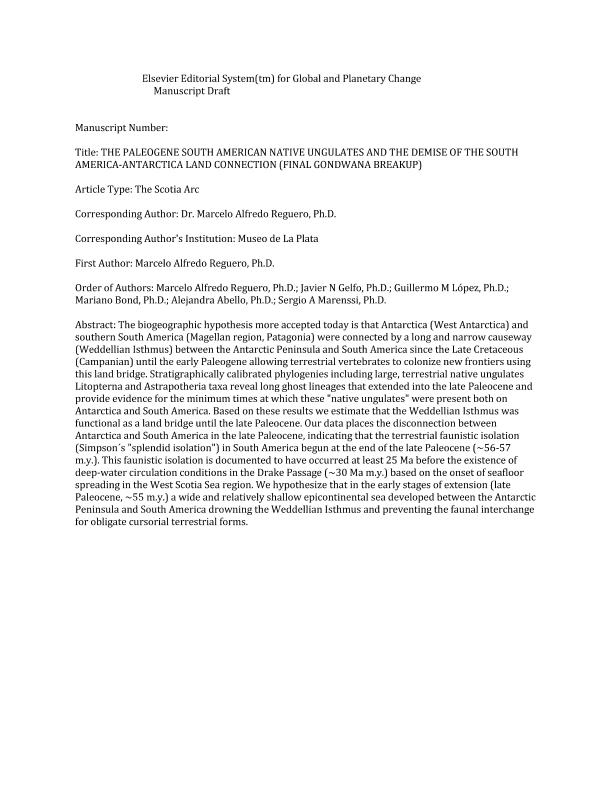Artículo
Final Gondwana breakup: The Paleogene South American native ungulates and the demise of the South America-Antarctica land connection
Reguero, Marcelo Alfredo ; Gelfo, Javier Nicolás
; Gelfo, Javier Nicolás ; López, Guillermo Marcos; Bond, Mariano
; López, Guillermo Marcos; Bond, Mariano ; Abello, María Alejandra
; Abello, María Alejandra ; Santillana, Sergio N.; Marenssi, Sergio Alfredo
; Santillana, Sergio N.; Marenssi, Sergio Alfredo
 ; Gelfo, Javier Nicolás
; Gelfo, Javier Nicolás ; López, Guillermo Marcos; Bond, Mariano
; López, Guillermo Marcos; Bond, Mariano ; Abello, María Alejandra
; Abello, María Alejandra ; Santillana, Sergio N.; Marenssi, Sergio Alfredo
; Santillana, Sergio N.; Marenssi, Sergio Alfredo
Fecha de publicación:
12/2014
Editorial:
Elsevier Science
Revista:
Global and Planetary Change
ISSN:
0921-8181
Idioma:
Inglés
Tipo de recurso:
Artículo publicado
Clasificación temática:
Resumen
The biogeographic hypothesis more accepted today is that Antarctica (West Antarctica) and southern South America (Magellan region, Patagonia) were connected by a long and narrow causeway (Weddellian Isthmus) between the Antarctic Peninsula and South America since the Late Cretaceous (Campanian) until the Early Paleogene allowing terrestrial vertebrates to colonize new frontiers using this land bridge. Stratigraphically calibrated phylogenies including large, terrestrial native ungulates Litopterna and Astrapotheria taxa reveal long ghost lineages that extended into the Late Paleocene and provide evidence for the minimum times at which these "native ungulates" were present both on Antarctica and South America. Based on these results we estimate that the Weddellian Isthmus was functional as a land bridge until the Late Paleocene. Our data place the disconnection between Antarctica and South America in the Late Paleocene, indicating that the terrestrial faunistic isolation (Simpson's "splendid isolation") in South America begun at the end of the Paleocene (~ 56 to 57 m.y.). This faunistic isolation is documented to have occurred at least 25. Ma before the existence of deep-water circulation conditions in Drake Passage (~ 30 m.y.) based on the onset of seafloor spreading in the west Scotia Sea region. We hypothesize that in the early stages of extension (Late Paleocene, ~ 55 m.y.) a wide and relatively shallow epicontinental sea developed between the Antarctic Peninsula and South America drowning the Weddellian Isthmus and preventing the faunal interchange for obligate cursorial terrestrial forms.
Archivos asociados
Licencia
Identificadores
Colecciones
Articulos(IGEBA)
Articulos de INSTITUTO DE GEOCIENCIAS BASICAS, APLICADAS Y AMBIENTALES DE BS. AS
Articulos de INSTITUTO DE GEOCIENCIAS BASICAS, APLICADAS Y AMBIENTALES DE BS. AS
Citación
Reguero, Marcelo Alfredo; Gelfo, Javier Nicolás; López, Guillermo Marcos; Bond, Mariano; Abello, María Alejandra; et al.; Final Gondwana breakup: The Paleogene South American native ungulates and the demise of the South America-Antarctica land connection; Elsevier Science; Global and Planetary Change; 123; Part B; 12-2014; 400-413
Compartir
Altmétricas



